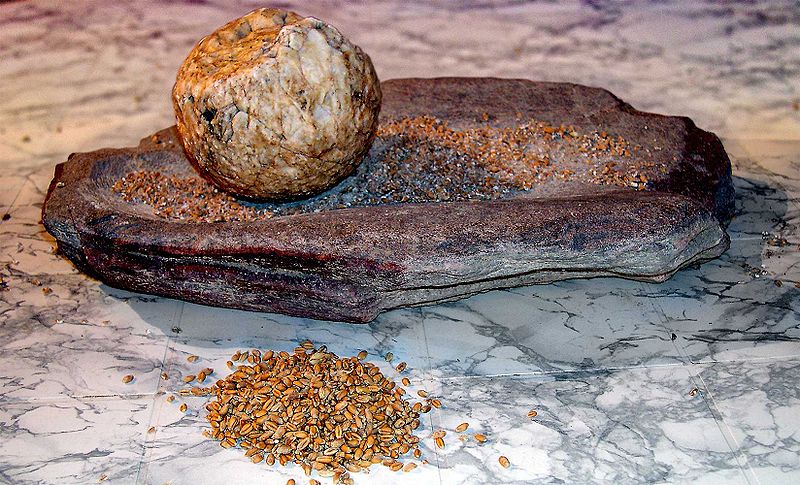Thousands of years before recorded human history, anthropologists have traced the evolution of human society from a nomadic hunter-gatherer phase to the rise of agricultural practices, which allowed people to stay settled in one place, form complex societies, and ultimately early civilizations. This transition, it is said, was so momentous that it has become known as the Agricultural Revolution. A few decades ago, however, a scholar posited that humans lost leisure time in the process, becoming virtual slaves to their new agricultural lifestyles that required hours of maintenance daily. This counterargument declared that the Agricultural Revolution was nothing less than the greatest disaster to ever befall mankind.
“Not so fast!,” says our guest this week. Rachel Laudan, a renowned food historian and author of Cuisine and Empire: Cooking in World History, argues that this thesis, which has found a champion in Jared Diamond’s best-selling Guns, Germs & Steel, fails to take food preparation into account. Our interview offers a different perspective and raises some new questions about the social impact of the beginnings of agriculture.
Guests
 Rachel LaudanIndependent Scholar and Visiting Research Affiliate, Institute for Historical Studies at the University of Texas at Austin
Rachel LaudanIndependent Scholar and Visiting Research Affiliate, Institute for Historical Studies at the University of Texas at Austin
Hosts
 Christopher RosePostdoctoral Fellow, Institute for Historical Studies, The University of Texas at Austin
Christopher RosePostdoctoral Fellow, Institute for Historical Studies, The University of Texas at Austin
Today, we’re going to be talking about a recent hypothesis that’s come up in relation to the agricultural revolution–which is a prehistoric topic, we don’t have any written records about it–that suggests that the agricultural revolution might not have been the Great Leap Forward that it was always believed to have been for mankind. So, I’m going to start off by asking if you could just very briefly describe what the agricultural revolution was, and what the traditional understanding of what that did for human development was.
The name agricultural revolution was introduced in the early 20th century by the renowned Marxist archaeologist and historian Gordon Child to describe the transition of human beings from a stage in which they obtain their food by hunting and gathering to a stage in which they obtained most of their food by farming, as he saw it, and this is indicated by the word “revolution.” It had two features. One was that it was a relatively quick and dramatic event. And the other was that it was a great leap forward in human history. Because following the shift to farming mankind, humankind quickly move to cities, states, and the whole growth of what we tend to call civilization. Both of those positions have been challenged in recent years. Almost nobody now believes that the agricultural revolution was a rapid event, it’s usually assumed now to have taken thousands of years because it is such a difficult shift to make. But perhaps more interesting for this podcast, the idea that it was a great step forward has also come under serious attack.
I first encountered this actually, during initial discussions about doing this podcast, and I found an entry on your blog, which is linked to on our website–that it’s now been posited that this was actually something of a disaster. And I find that really remarkable. What is the critique, or the hypothesis, that’s being put forward now?
The critique also came from anthropologists who were looking at hunter-gatherer societies that are still around in the world today, and they decided that these hunter gatherers had a life, comparatively speaking, of leisure. Unlike the poor modern worker who has to go to the office or to work from nine to five, five days a week, stereotypically hunter-gatherers, it seemed, only have to work for two or three days to collect all the food they needed. The anthropologist Marshall Sahlings, who was a leading figure from Chicago, called the period before the agricultural revolution, the “original affluent society”–affluent because people could get everything they needed to live with relatively little work.
Normally, I try not to offer my opinion during an episode. But I’m finding this a bit of a stretch.
Well, there was detailed work some of the work. The most important work was carried out by Richard Borshay Lee in the Kalahari Desert among the !Kung San or the Bushmen, as they’re normally called in popular parlance, and he went down there for a number of months and he studied what they did and he found that they left camp in the morning on two or two and a half days a week and return to camp in the evening with enough mongongo nuts to sustain them during the rest of the week.
Okay. So as a hypothesis, is this generally accepted? What is–as a food historian, what is your take on that?
Well, it is widely accepted. Many of your listeners may have read a book by another anthropologist Jared Diamond called Guns, Germs and Steel, which I think is widely used in high schools. And Jared Diamond, prior to writing that book, asked the question “Was the agricultural revolution, the worst disaster in the history of the human race?”
–the worst disaster–
–the worst disaster in the history of the human race. And this came out in Discover magazine, which is widely read, it was a very easily readable essay, and this has become very much the common opinion. Now, I think that you can only get away with this if you have a very funny notion of food. And you have a very funny notion of work.

For example, you mentioned the, I’m sorry, I can’t pronounce the name of the Kalahari tribesfolk. Apparently, they’re living entirely on these nuts.
Almost entirely. There are a few other things, they will catch some small animals, there are insects, there are some other fruits and plant materials, but the mongongo nut is the staple of their diet. Now, what I think is wrong with this analysis is that anthropologists were only paying attention to the collection of the mongongo nuts. Now a mongongo nut is a very, very hard nut. And we can tell you some stories about how you can soften it a moment if you like. But in order to eat a mongongo nut you have to get the shell off. And the shell if you think of a Brazil nut, or a black walnut, or a macadamia nut, it’s a very, very hard shell. So you have to heat the mongongo nut in the fire to soften the shell. And then you have to crack the mongongo nut. Now you might say so cracking a few nuts, who cares? But the meat inside the nut, the actual nut itself is tiny. It’s smaller than a marble, and it’s all twisted into the shell, just like a pecan is, so that to get enough actual nut meat to fill your belly, you are going to have to be cracking an awful lot of mongongo nuts. And when I went back and looked at the work that Lee did in the Kalahari, it turned out that it took eight hours a week just to crack the mongongo nuts. So you’ve got a whole extra day of work in there just cracking.

And that’s before you’ve prepared any of the other foodstuffs.
That’s before you’ve prepared any other food stuffs, it’s before you have collected the wood for the fire, it is before you have gone off and collected the water that you need to drink, which is very time consuming in the Kalahari. And traditionally, the largest container you had was an ostrich egg, which, although it’s fairly big, you’ve got to carry a lot of water in ostrich eggs to have enough for a whole camp. So when you do the calculations, and you add in food processing, and all the ancillary work to food processing, that is firewood, water, and so on, it turns out that these together run between 30 and 40 hours a week. So if you add that on to the gathering of the mongongo nuts, you have a total work week of six to seven eight-hour days, not the two-and-a-half that the anthropologists praise when they talk about a life of leisure.
One also has to presumably take into account that life expectancy was not particularly long, and that the availability of food could not be guaranteed in a hunter gatherer society.
There was always uncertainty about where their food was coming from. And there was always a hungry season. Mongongo nuts, for example, store fairly well, but towards the end of the year you are running out of a ready supply of mongongo nuts. No, it wasn’t a paradise. But for me, as a food historian, I think this is symptomatic of a huge gap that we have in history at the moment. There is a vast literature on and discussion of the history of agriculture. What hard work it is how plowing and sewing and harvesting your crops is a very laborious and energy intensive activity.
But where do we have the discussions about what happens after harvest, because we don’t eat plants, we don’t eat harvests. We don’t eat animals, we don’t eat animal carcasses. We only eat those when they have been turned into something edible and turning harvests and carcasses into something edible in the research I have done always, as in the case of the mongongo nuts, takes longer than the collection of farming of food in the first place. So I think we have to begin to look seriously at the enormous labor that humans took on once, unlike animals, they began to eat food that have been transformed from the natural state.
So what what did happen with the preparation of food, when you move from this hunter gatherer phase into a an agricultural phase, where you’re actually controlling what’s grown?
Again, I think we have to rethink the agriculture revolution. nobody would farm unless they knew how to turn what they farmed into food. And what they farmed initially, in most parts of the world, was grains, the seeds of annual herbaceous plants. Now, grains are a very mixed blessing, they grow abundantly, they can be harvested every year, they are tiny and hard, because they’re the seeds for the next year. So they store very well, much better than mongongo nuts, for example. So those are all the benefits. And another benefit is that they are one of the most nutritionally complete kinds of foods, because they are the food for new plants.
The trouble is because they are tiny, and because they are hard as nails, literally turning them into food is enormously laborious. With the agricultural revolution, somebody had to take on the business of turning wheat, or barley, or corn or rye, oats, into food. And that means grinding. And so far as I am able to ascertain, both from experiments with grind stones, observing modern women grinding and the historical record for a family of four, it would take a woman about five hours a day to grind the grains. Now, think about the implications of that, for history. If you are to have rulers who do not grind, somebody has to be grinding for them. If you are to have women raising families, and they’re spending five hours a day grinding, and then they have to collect firewood and war, they have no option of doing anything else with their lives, essentially, except grind. And that is a stunning historical fact that I think we really need to come to terms with.
Do we have any sense of what the division of labor might have been in the hunter gatherer phase to compare it to? Or do we know?
Historians are–
–We don’t.
–are just not asking these questions. And my mission, or one of my missions is to persuade archaeologists and historians to look very seriously of the question of who is doing these transformations that make the raw materials of food into something we can actually put in our mouths, and how long it takes them, and how much energy it takes. Because I think a lot of the origins of inequality lie here. I think a lot of differences between different societies lie here. I think even the origins of large organized labor lie here because a court for example, a ruler has a court and if he has a court, he has to have a kitchen staff of hundreds, sometimes thousands of people, many of whom a large proportion of whom doing nothing but grind for the ruling class, as well as growing.
I know, as late as the 18th, 19th century, it was estimated in the Ottoman Empire that for every person who lived in Constantinople, there had to be three people producing full time to support one resident in the city.
Exactly. And they are not counted. And there’s going to be another three doing nothing but preparing the food.
Exactly, exactly. This is this is so fascinating. And we could we could, we could stay here all day talking about this, but keeping an eye on the clock and are a general format. But I would definitely urge any listeners who are interested in this topic. You have a wonderful blog at your website, Rachellaudan.com, as well as your book Cuisine and Empire which I’ve been reading for the last week, which is absolutely fascinating read, it’s it’s easy to dip into and out of and, and it brings a whole new dimension to world history.
More Resources
“Was the Agricultural Revolution a Terrible Mistake? Not If You Take Food Processing into Account.”—the post on Rachel’s blog that inspired this episode (lots of photos and links — we won’t steal them; you should go read for yourself!)
“The Worst Mistake in the History of the Human Race,” 1987 article in Discover Magazine by Jared Diamond presenting the argument later laid out in Guns, Germs & Steel.